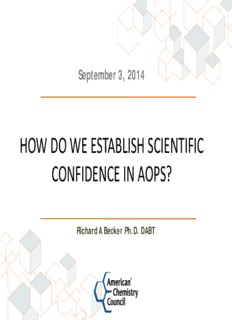
How Do We Establish Scientific Confidence in AOPs? PDF
Preview How Do We Establish Scientific Confidence in AOPs?
September 3, 2014 HOW DO WE ESTABLISH SCIENTIFIC CONFIDENCE IN AOPS? Richard A Becker Ph.D. DABT Scientific Confidence is a Necessity • Must have confidence to rely on AOPs for decision making in product stewardship & regulatory actions • Problem Formulation --- degree of confidence depends on intended use: • E.G., priority setting would require less confidence than risk assessment 2 • Considered how existing frameworks could be adapted: • OECD’s “Validation Principles for (Q)SAR” • Inst. of Medicine’s “Evaluation of Biomarkers and Surrogate Endpoints” 3 open access: http://www.ncbi.nlm.nih.gov/pubmed/24845243 A focus on this case example helped refine our thinking on a framework and extend it to AOPs 4 Scientific Confidence Framework for AOPs (adapted from Cox et al. 2014 Reg Tox Pharm) 1 Develop the AOP 2 Develop new (or map existing) specific assays to key events within the AOP 3 Conduct (or document) Analytical Validation of each assay 4 Develop new (or map existing) models that predict a specific key event from one or more pre-cursor key events. (The input data for the prediction models comes from the assays described in Steps 2 and 3 above.) 5 Conduct (or document) Qualification of the prediction models 6 Utilization: defining and documenting where there is sufficient scientific confidence to use one or more AOP-based prediction models for a specific purpose (e.g., priority setting, chemical category formation, integrated testing, predicting in vivo responses, etc.) 7 For regulatory acceptance and use, processes need to be agreed upon and utilized to ensure robust and transparent review and determination of fit for purpose uses of AOPs. This should include dissemination of all necessary datasets, model parameters, algorithms, etc., to enable stakeholder review and comment, fully independent verification and independent scientific peer review. While these processes have yet to be defined globally, in time, these should evolve to enable scientific confidence and credible and transparent use of AOPs. 5 This framework was presented at 2014 SOT : The Toxicologist, Abstract 2253, page 602. Prototype -- Estrogen AOP 6 Mapping assays to the AOP 7 Scientific Confidence Framework for AOPs 1. Analytical Validation Assessment of the biological basis and analytical performance of assays. • Each assay should map to a defined mechanistic endpoint (e.g., a key event in the mode of action or AOP). • Documentation of assay performance characteristics (reliability, sensitivity, and specificity) • A defined chemical domain of applicability • Transparent data sets (to enable independent verification) should be readily available. Note This framework was used to form the basis of the draft OECD guidance “Characterizing non-guideline in vitro test methods to facilitate their consideration in regulatory applications” 8 Scientific Confidence Framework for AOPs 2. Qualification Assessment of the prediction model derived from the assays. • A defined algorithm for each prediction model. • Appropriate measures of goodness-of-fit, robustness and predictivity of the prediction models (models may be quantitative or qualitative). • Known limitations of each prediction model should be summarized. • Prediction models should be characterized in sufficient detail to facilitate review, reconstruction and independent verification of results. 9 Predicting E, A, T & S in vivo from ToxCast Results Environ Health Perspect. 2013 Jan;121(1):7-14. The authors concluded: ToxCast estrogen receptor-mediated and androgen receptor-mediated assays predicted the results of relevant EDSP T1S assays with balanced accuracies of 0.91 (p < 0.001) and 0.92 (p < 0.001), respectively. Models for steroidogenic and thyroid-related effects could not be developed with the currently published ToxCast data. 10
Description: